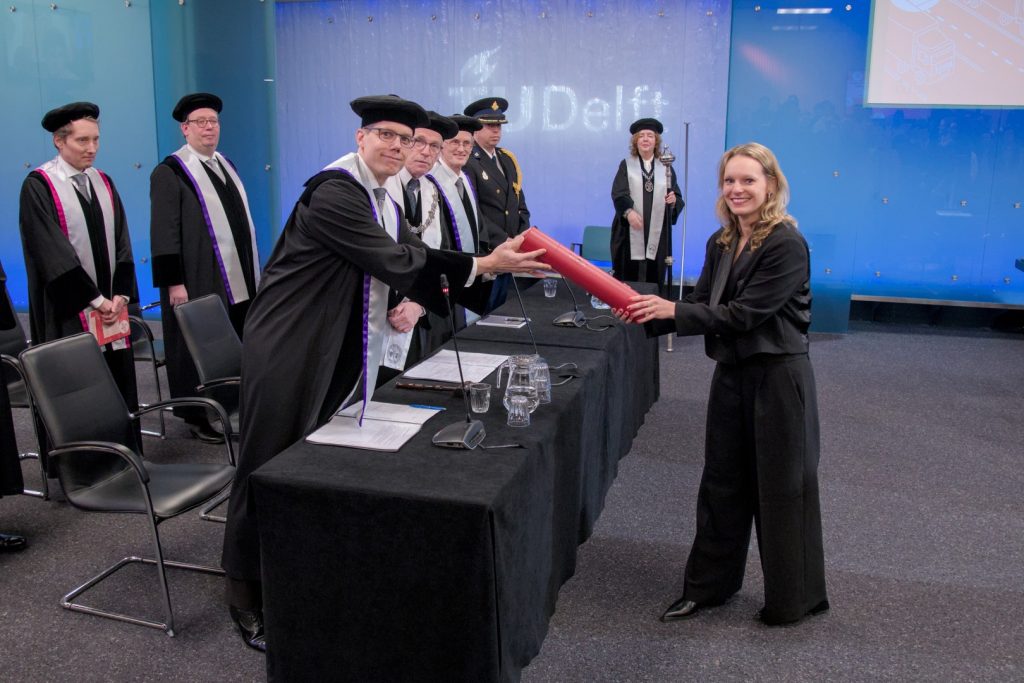Simulation approach for reconstructing illicit supply chains
Last month, Portwise’ project manager, Isabelle van Schilt, defended her PhD titled “Reconstructing illicit supply chains with sparse data: A simulation approach” at Delft University of Technology. Her research presents cutting-edge contributions for both the field of supply chain management and simulation modelling, and implications for the academic world as well as for practitioners.
Even in this digital era, the data for improving supply chain visibility, such as data on demand, inventory levels, processing times of a manufacturer, and transportation times, is often sparse due to the actors’ reluctance to share information or because of high cost of technology solutions. This leads to uncertainties in the operational aspect within a supply chain (e.g., inventory, travel times) as well as the structural aspect (e.g., number and location of the actors, which import and export ports are used). In particular, illicit supply chains suffer from limited information and a high level of uncertainty, making it challenging to effectively disrupt this supply chain. Recent studies focus advanced ICT systems to collect visibility data. However, gathering more data using, for example, collaboration is not always a given, especially for illicit supply chains.
Her dissertation demonstrates a simulation approach for reconstructing illicit supply chains, that could help robust decision-making on effective interventions. Simulation modelling of supply chains is an approach to get insight into the behaviour of complex systems, recognize relations over time, and explore future (“what-if”) scenarios. Model calibration, i.e., the process of tuning and estimating the simulation model parameters using observed data to match the real system, is essential.
When calibrating a simulation model with sparse data, there is a large variety of plausible simulation models that could explain the sparse observations about the real-world supply chain, i.e., equifinality. Only focusing on one model for analysis could lead to a “poor” understanding of the system, and hence misplaced interventions in the real world. Thus, a diverse ensemble of models is needed to analyse the robustness of interventions in such cases instead of a single model, yet this is harder to find.
Therefore, her dissertation addresses how to generate a diverse ensemble of reconstructions of a supply chain, in cases where the available data is sparse. A simulation calibration approach in combination with a ground truth simulation model is used.
Insights for practitioners and decision-makers
This dissertation highlights three main contributions for supply chain practitioners and decision-makers:
- Understanding of how to cope with sparseness of the currently available data and how this sparseness impacts supply chain visibility. Missing data hampers the visibility of the supply chain the most.
- The importance of gathering information of the upstream supply chain, especially in the case of a push-pull supply chain.
- There is not a single model for a supply chain when the available data is sparse, but there could be multiple models. The ensemble of models allows us to make more robust decisions in the logistics sector.
Future-proof logistics
Although this dissertation focuses on illicit supply chains, many legitimate supply chains also cope with limited data availability due to, for example, the lack of collaboration, and the need for robustness. Ports are an essential part of the supply chain, as they are at the core of the international distribution of goods. However, similar challenges occur for port authorities and terminal operators when making decisions. With maritime volume expected to increase substantially in the coming years, the call for robustness becomes increasingly urgent.
Especially in today’s unpredictable and ever-changing world, the need for future-proof logistics is more pressing than ever. Therefore, it is important for practitioners to be aware of the limitations that (imperfect) data brings. In this light, validating and checking the quality of the data with experts is essential. In addition, the purpose of data gathering should be clear from the start to determine the data quantity – too little data leads to overfitting of models, whereas too much data which is not relevant leads to redundancy, both resulting in “poor” decision-making.
Next, recognizing that the logistic operations and container terminals should be evaluated across a variety of future scenarios (multiple models of the reality) is important for future-proof logistics. If the operation performs satisfactory across a wide set of models, it can be seen as robust. With the upcoming challenges in mind – whether this is climate change, geopolitical, inflation, logistical disruptions or any other disrupting event – it is important to strive for logistical design and operations that are robust.
Portwise’s mission is to help and transform maritime and logistics sector to become future and planet proof. Would you like to learn more about how your container terminal or logistics operation could be more future-proof? Or would you like to evaluate your innovation supporting a future-proof logistic sector using simulation? Please reach out to learn more about Portwise’s services.
The online version of the dissertation is available here.
 Picture: Isabelle van Schilt, receiving her PhD title at Delft University of Technology.
Picture: Isabelle van Schilt, receiving her PhD title at Delft University of Technology.